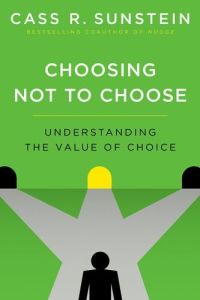Join getAbstract to access the summary!

Join getAbstract to access the summary!
Cass R. Sunstein
Choosing Not to Choose
Understanding the Value of Choice
Oxford UP, 2015
What's inside?
The right to choose is a blessing. It can also be a curse. Sometimes, it is better to choose not to choose.
Recommendation
Harvard professor, frequent author and legal scholar Cass R. Sunstein addresses choice, the topic of some of his previous books, including Republic.com and Nudge. He focuses on the architecture of choosing by addressing often-neglected aspects of choice, like the power of “default choices.” His prose and reasoning are exceptionally lucid. Sunstein discusses academic studies, theoretical concepts, practical examples and real-world applications. The result, despite a few repeating loops, provides an essential overview for anyone interested in decision making, as well as public policy, clear thinking and how people think. getAbstract recommends Sunstein’s rigor and imagination to those readers, and to leaders, marketers and social scientists.
Summary
About the Author
Harvard professor Cass R. Sunstein – author of Going to Extremes, Simpler, Nudge and other books – ran the White House Office of Information and Regulatory Affairs from 2009 to 2012.































Comment on this summary